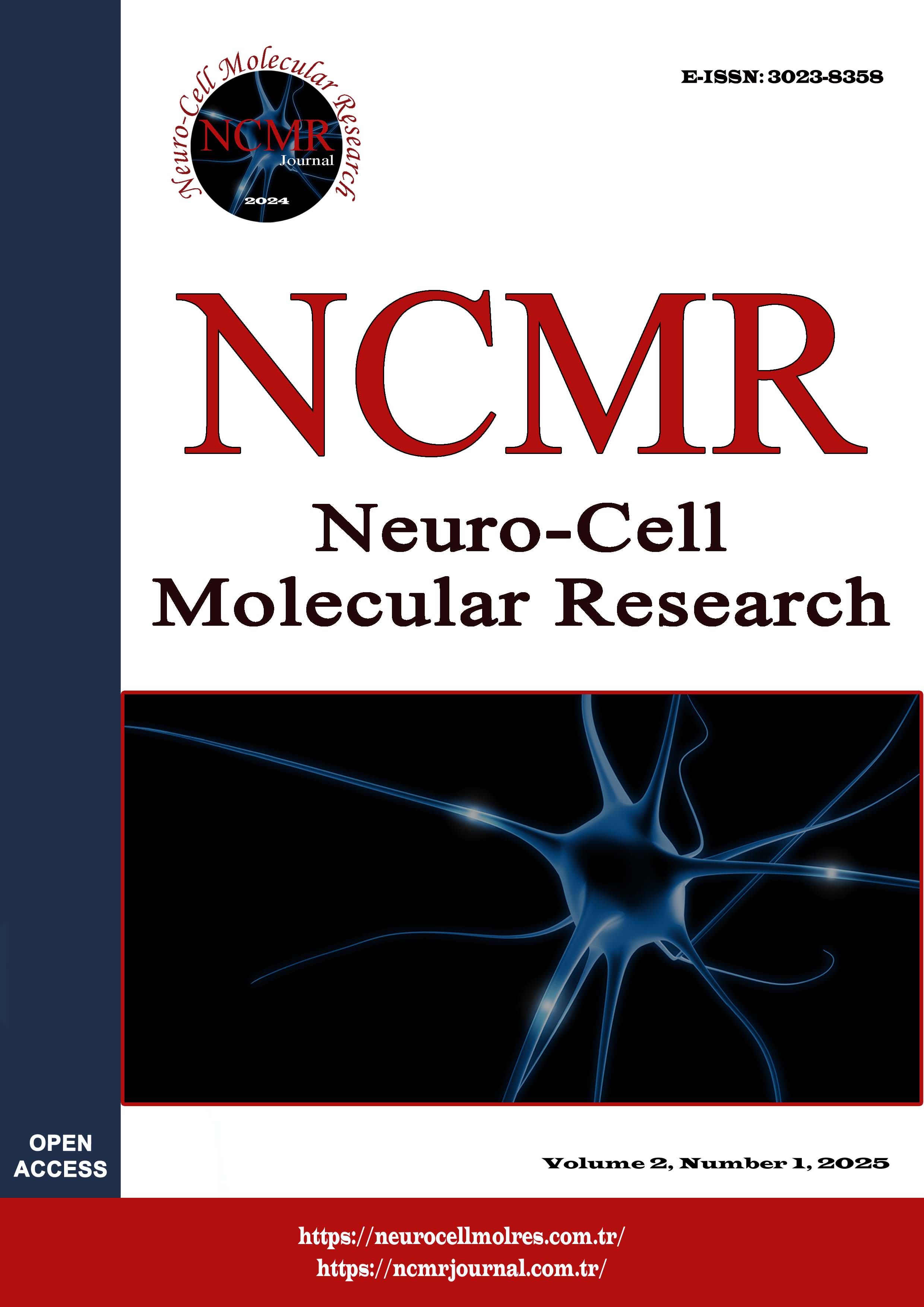The effect of sulforaphane against glutamate-induced oxidative stress and inflammation in SH-SY5Y cells
DOI:
https://doi.org/10.5281/zenodo.15313159Anahtar Kelimeler:
Glutamate- Sulforaphane- SH-SY5Y cells- Excitotoxicity- Oxidative stressÖz
Glutamate (GLT) induced excitotoxicity plays a central role in the pathogenesis of various neurodegenerative diseases through mechanisms involving oxidative stress and inflammation. Sulforaphane (SFN), a natural isothiocyanate derived from cruciferous vegetables, has demonstrated neuroprotective effects. This study aimed to investigate the protective effects of SFN against glutamate-induced oxidative stress and inflammation in SH-SY5Y neuroblastoma cells. SH-SY5Y cells were divided into four experimental groups: (1) Control, (2) SFN (5 µM SFN for 30 min), (3) GLT (10 mM glutamate for 24 h), and (4) GLT + SFN (pre-treatment with SFN followed by glutamate exposure). TAS and TOS levels, and pro-inflammatory cytokine expression (TNF-α and IL-1β) were evaluated using standard biochemical assays. GLT exposure significantly increased TOS and pro-inflammatory cytokine levels, reducing TAS levels. Pretreatment with SFN reduced the levels of TOS and inflammatory markers compared to the GLT group, and increased the levels of TAS.
SFN exerts a protective effect against GLT-induced cytotoxicity in SH-SY5Y cells, likely through its antioxidative and anti-inflammatory properties. These findings suggest that SFN may have therapeutic potential in neurodegenerative disease models.
İndirmeler
Referanslar
Jakaria M, Park SY, Haque ME, Karthivashan G, Kim IS, Ganesan P, et al. Neurotoxic agent-induced injury in neurodegenerative disease model: Focus on involvement of glutamate receptors, Frontiers in molecular neuroscience, 2018;(11):307. https://doi.org/10.3389/fnmol.2018.00307
Binvignat O, Olloquequi J. Excitotoxicity as a target against neurodegenerative processes, Current Pharmaceutical Design, 2020, 26(12):1251-1262. https://doi.org/10.2174/1381612826666200113162641
Zorov DB, Juhaszova M, Sollott SJ. Mitochondrial reactive oxygen species (ROS) and ROS-induced ROS release, Physiological reviews, 2014;94(3):909-950. https://doi.org/10.1152/physrev.00026.2013
Kritis AA, Stamoula EG, Paniskaki KA, Vavilis TD. Researching glutamate–induced cytotoxicity in different cell lines: a comparative/collective analysis/study, Frontiers in cellular neuroscience, 2015;(9):91. https://doi.org/10.3389/fncel.2015.00091
Yıldızhan K, Nazıroğlu M. Protective role of selenium on MPP+ and homocysteine-induced TRPM2 channel activation in SH-SY5Y cells, Journal of Receptors and Signal Transduction, 2022;42(4):399-408. https://doi.org/10.1080/10799893.2021.1981381
Çınar R, Ahlatcı A. TRPM2 channel contribution to CdCI2-related neurotoxicity in SH-SY5Y cells: Protective role of selenium: Effect of Se in CdCI2-related neurotoxicity, Neuro-Cell Molecular Research, 2024;1(2):40-46. https://doi.org/10.5281/zenodo.13623107
Stojanovic IR, Kostic M, Ljubisavljevic S. The role of glutamate and its receptors in multiple sclerosis, Journal of Neural Transmission, 2014;(121):945-955. https://doi.org/10.1007/s00702-014-1188-0
Loboda A, Damulewicz M, Pyza E, Jozkowicz A, Dulak J. Role of Nrf2/HO-1 system in development, oxidative stress response and diseases: an evolutionarily conserved mechanism, Cellular and molecular life sciences, 2016;73:3221-3247. https://doi.org/10.1007/s00018-016-2223-0
Chen X, Liu J, Chen SY. Sulforaphane protects against ethanol‐induced oxidative stress and apoptosis in neural crest cells by the induction of N rf2‐mediated antioxidant response, British journal of pharmacology, 2013;169(2):437-448. https://doi.org/10.1111/bph.12133
Wang C, Wang C. Anti-nociceptive and anti-inflammatory actions of sulforaphane in chronic constriction injury-induced neuropathic pain mice, Inflammopharmacology, 2017;25:99-106. https://doi.org/10.1007/s10787-016-0307-y
de Oliveira MR, Brasil FB, Fürstenau CR. Sulforaphane attenuated the pro-inflammatory state induced by hydrogen peroxide in SH-SY5Y cells through the Nrf2/HO-1 signaling pathway, Neurotoxicity Research, 2018;34(2):241-249. https://doi.org/10.1007/s12640-018-9881-7
Doğan M, Yıldızhan K. Investigation of the effect of paracetamol against glutamate-induced cytotoxicity in C6 glia cells, Cumhuriyet Science Journal, 2021;42(4):789-794. http://dx.doi.org/10.17776/csj.999199
Lau A, Tymianski M. Glutamate receptors, neurotoxicity and neurodegeneration, Pflügers Archiv-European Journal of Physiology, 2010;460:525-542. https://doi.org/10.1007/s00424-010-0809-1
Ahlatcı A. Investıgatıon of The Amelıoratıve Effects of Gallic Acid Agaınst Neurotoxicity Caused by Glutamate in C6 Cells: Effect of gallic acid on Glutamate-Induced neurotoxicity, Neuro-Cell Molecular Research, 2024;1(1):7-13. https://doi.org/10.5281/zenodo.11471554
Balkhi HM, Gul T, Banday MZ, Haq E. Glutamate excitotoxicity: an insight into the mechanism, International Journal of Advanced Research, 2014;2(7):361-373.
Ma Q, Role of nrf2 in oxidative stress and toxicity, Annual review of pharmacology and toxicology, 2013;53(1):401-426. https://doi.org/10.1146/annurev-pharmtox-011112-140320
Surh YoungJoon SY, Kundu JK, Na HyeKyung NH. Nrf2 as a master redox switch in turning on the cellular signaling involved in the induction of cytoprotective genes by some chemopreventive phytochemicals, Planta medica, 2008;74(13):1526-1539. https://doi.org/10.1055/s-0028-1088302
Alcarranza M, Villegas I, Muñoz-García R, Recio R, Fernández I, Alarcón-De-La-Lastra C. Immunomodulatory effects of (R)-sulforaphane on LPS-activated murine immune cells: molecular signaling pathways and epigenetic changes in histone markers, Pharmaceuticals, 2022;15(8):966. https://doi.org/10.3390/ph15080966
Fragoulis A, Laufs J, Müller S, Soppa U, Siegl S, Reiss LK, et al. Sulforaphane has opposing effects on TNF-alpha stimulated and unstimulated synoviocytes, Arthritis research & therapy, 2012;14:1-10. https://doi.org/10.1186/ar4059
Bijangi-Vishehsaraei K, Saadatzadeh MR, Wang H, Nguyen A, Kamocka MM, Cai W, et al. Sulforaphane suppresses the growth of glioblastoma cells, glioblastoma stem cell–like spheroids, and tumor xenografts through multiple cell signaling pathways, Journal of neurosurgery, 2017;127(6):1219-1230. https://doi.org/10.3171/2016.8.JNS161197
Guerrero-Beltrán CE, Calderón-Oliver M, Pedraza-Chaverri J, Chirino YI. Protective effect of sulforaphane against oxidative stress: recent advances, Experimental and Toxicologic Pathology, 2012;64(5):503-508. https://doi.org/10.1016/j.etp.2010.11.005





